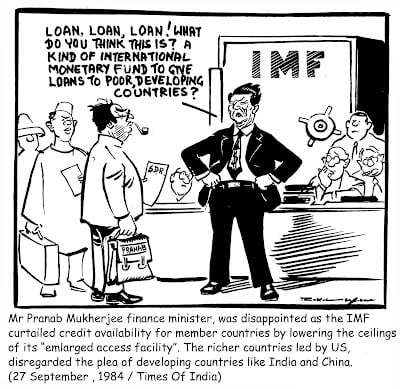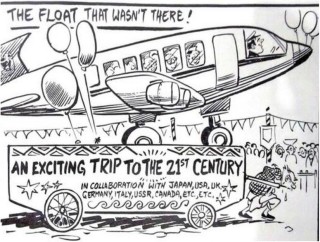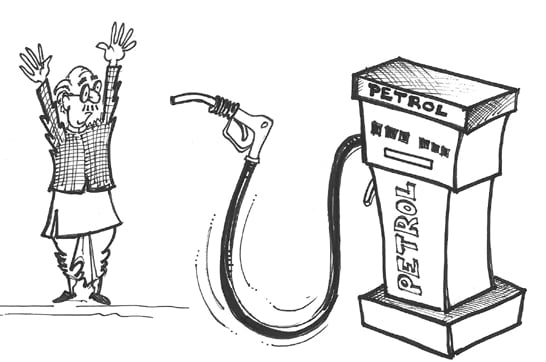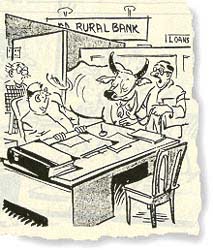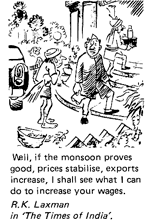“I drew objects that caught my eye outside the window of my room— the dry twigs, leaves and lizard like creatures crawling about, the servant chopping firewood and of course, the number of crows in various postures on the rooftops of the buildings opposite?” – Laxman in his autobiography Tunnel of Time.
R.K. Laxman even though not with us today, has left a legacy of caricatures that will keep on reminding us about his ‘Common Man’who touched the hearts of millions every morning.
With an uncanny perception and sarcasm, Laxman’s cartoons revolved around the political and economic dimensions of Indian Economy. Illustrating idiosyncrasies and peculiarities of everyday life in India, the Uncommon Man used his Common Man to depict the Economic turbulences in the economy from time to time.
Let’s take a look at some of the Economic Issues which were portrayed in Laxman’s cartoons.
- 1984, this was the year when industrial and developing countries decided on action to curtail international credits available for loans to debt-burdened countries by the International Monetary Fund. The action which reduces access to the I.M.F.’s resources came about as a result of a compromise chiefly between the United States, which sought deep cuts, and developing countries led by India, which wanted no cut at all. A decision dominated by the motives of the Developed Nations like US, India’s then Finance Minister, Pranab Mukherjee was deeply disappointed.
The above caricature hence throws light on IMF’s take on providing credit facilities to the under-developed and the developing nations.
- Sketching Rajiv Gandhi’s slogan ‘Let’s lead India into 21st Century’, Laxman came up with the following caricature:
The Indian Economy which dreamt to fly high towards the 21st century with the support of other nations like Japan, US, UK, etc. never actually took off during Rajiv Gandhi’s reign, instead it contributed to the plight of the common man.
- ‘Economic Growth and Development’- These are the key terms in every political party’s election manifesto. But what actually happens after these parties ascend the throne is unraveled by Laxman in his next caricature!
‘Enough of discussions and debates, let your actions do the talking’.
- Petrol Price Hike- In a country where a person experiences hikes in petrol prices more often than his salary, the maestro illustrated the plight of the common man due to soaring oil and petrol prices in the following caricature. When the government puts the burden of blame on the market forces and its treasury falling short of funds, it is the Aam Aadmi who suffers the most.
- When the PM’s Jan Dhan Yojna has accelerated the extent of Financial Inclusion in the nation, Laxman’s next caricature mocks the status-quo wherein loans are being desperately served on a platter in the rural areas where the residents just have their farm animals to mortgage!
- ‘Trickle-down economics is a hoax’– If an economy develops, the benefits of its growth will reach out to the poorer sections. This theory certainly holds no relevance in the Indian context where the gap between ‘haves’ and ‘have-nots’ widens continuously.
While Indian Economy is now growing at a faster pace, there has been no substantial increment in the wage rate in the labour market. But the woes of the common man are pacified to some extent by the green shots of hope that someday he will also reap the fruits of a developing economy.
From foreign policies to inflation, from diplomatic ties between nations to stagnated wages, R.K Laxman depicted it all. With the strokes of his pencil and the art to depict things with a whole new perspective, the iconic cartoonist exposed the hypocrisy in Indian politics. The complex economic theories and day to day occurrences in the world economy, everything transpired in the life of Laxman’s Common Man.
Not just for the laughs, the pot-pourri of his Common Man’s emotions and sentiments remains ageless and would be etched in our hearts for years to come.
Picture Courtesy: Times of India, Economic Times, Google Images
By Vaibhav Agarwal

























